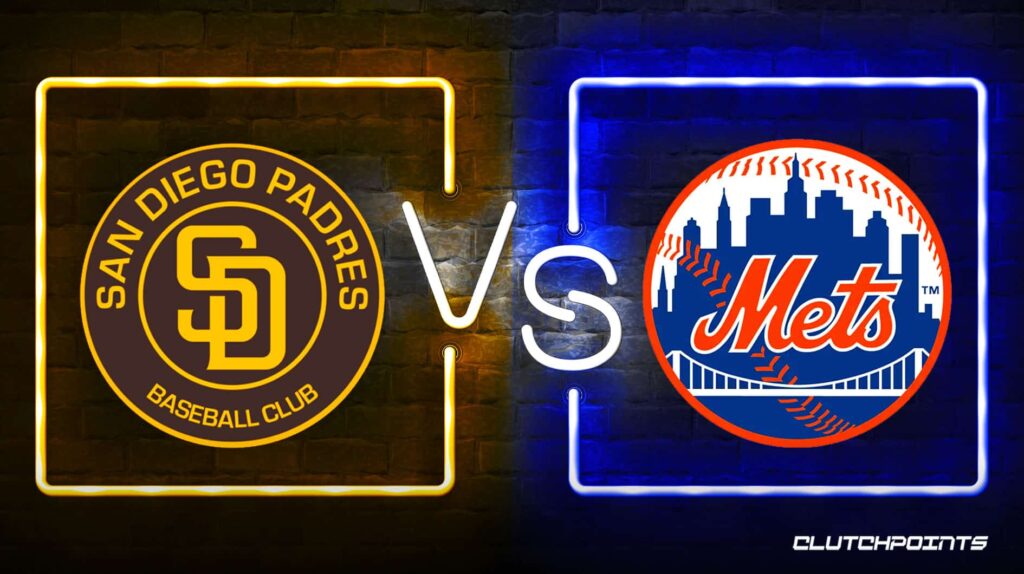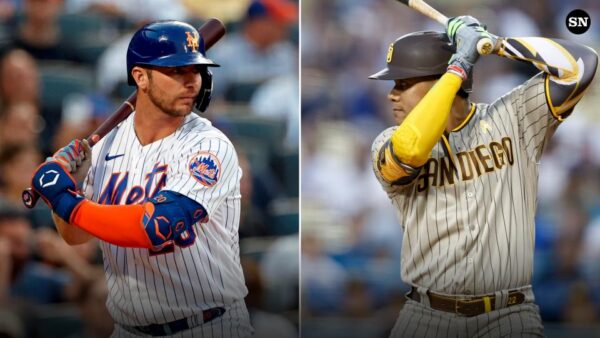Padres Playoff Primer: New York Mets

Credit: Clutchpoints

Playoffs. Prime Time. The San Diego Padres will play under the bright lights in the “Big Apple” in the Wild Card Round against the New York Mets.
For both sides, it will be the first time in a while that fans of each team can attend their team’s playoff game. The Mets are back in the playoffs for the first time since 2016 when Madison Bumgarner blanked New York at Citi Field to lead the San Francisco Giants to a wild card victory, while the Padres last played a playoff game in front of fans in 2006, but did reach the postseason in 2020 when fans were not allowed to attend due to COVID-19.
It is safe to say that Citi Field will be a lively postseason atmosphere full of rabid Mets fans and the Friar Faithful who have waited 16 years to attend a Padres playoff game.
Winning 100 games, the Mets are just the sixth team in baseball history to reach that plateau and not win its division. New York’s 101-61 record finished behind the Atlanta Braves due to the season series tiebreaker, whose surge in June overcame a 10.5-game lead in the NL East.
Like the Padres, New York saw drastic improvement under an experienced manager in his first year with the team, Buck Showalter. His already talented squad needed stability at the helm, which Showalter provided.
Strength: Starting rotation
When healthy, the Mets boast the league’s best pitcher, 2018 and 2019 NL Cy Young Award winner Jacob deGrom. He missed the first four months of 2022 before posting a 3.08 ERA in 11 starts. However, deGrom allowed three or more runs in each of his final four starts, so he is not in peak form. The last time he had a three-game stretch with three or more runs in each start was in April 2019.
deGrom does lack playoff experience as a lifelong Met, but his four outings in the Mets’ 2015 run to the World Series were strong. With all outings on the road, deGrom struck 29 batters in 25 innings while getting three wins. His lone loss came in the World Series when he only lasted five innings and allowed four runs. The Padres also got carved by deGrom in 2021 when he threw 13 combined scoreless innings in back-to-back starts against San Diego. He features a 99 MPH fastball with a wipeout slider at 93 MPH as his primary pitches but will mix in a few changeups and curveballs to change pitch speeds.
As if deGrom isn’t imposing enough, Max Scherzer is the next top starter and in fact, will start Game 1. Scherzer missed a handful of starts but still logged 145 innings while posting a 2.29 ERA in his age-37 season. He also boasts a plethora of playoff experience during his time with the Detroit Tigers and Washington Nationals and a cup of coffee with the Los Angeles Dodgers. In 128 innings across 21 starts and five relief appearances, “Mad Max” owns a 3.22 postseason ERA with 160 strikeouts. The Padres did enough to beat Scherzer in July, but the task will certainly be different now in October. Scherzer features five pitches that he all uses at least nine percent of the time, primarily being his 94 MPH fastball and his sweeping slider with nearly a +17 run value, according to FanGraphs.
Juan Soto’s final HR as a National was off of Max Scherzer, his teammate during the 2019 World Series run. Soto is the last domino to fall from that championship squad. pic.twitter.com/ZGqUdhKf3f
— Dylan Backer (@DylanBacker_) August 2, 2022
Chris Bassitt is likely the third starter for the Mets, edging out Taijuan Walker and his 3.49 ERA in 157 innings. Bassitt led New York in innings and held down the fort with a 3.42 ERA. Early in the 2016 season, Bassitt needed to undergo Tommy John surgery and missed the rest of that year and most of 2018. Since recovering and moving back to the rotation full-time in 2019, Bassitt’s worst season is a 3.81 ERA in 144 innings. He is, without a doubt, one of the most underrated pitchers in baseball. Bassitt logged 11 innings in two starts during the 2020 postseason for now-Padres manager Bob Melvin’s Oakland A’s while allowing just four runs. His pitch mix is more movement-oriented, with a fastball thrown 13% of the time, according to FanGraphs. Bassitt relies on a sinker and cutter combo that ranges from the low-90s to the upper-80s. His slider is his worst pitch, thrown 16% of the time at 80 MPH, while a looping curveball from Bassitt at 71 MPH keeps opposing hitters off balance.
What comes after the starters?
The bullpen for the Mets is an interesting one. It’s not the best group of pitchers and certainly isn’t very deep, but a strong backend holds them together. Across 560.2 innings, Mets relievers own a 3.55 ERA and are striking out 10.37 batters every nine innings. That earned run average is good for 10th in baseball, slightly better than the Padres’ 3.83 ERA, that ranks 14th.
Edwin Diaz is practically a lock to win the Trevor Hoffman NL Reliever of the Year Award. He took the baseball world by storm with his entrance to the trumpets and boasts a 1.31 ERA in 62 innings with a whopping 118 strikeouts. Diaz started throwing the slider, which has a +19 run value, as his primary pitch as opposed to his fastball, and it has worked wonders. Safe to say, the Padres don’t want to hear the trumpets this weekend. It will be Diaz’s first time in the postseason.
Yeah fully-rested Edwin Diaz is absolutely generational. Pin-point control of the high fastball last night, slider somehow looked more un-hittable than usual pic.twitter.com/W3FzlCS6tO
— jack (@Jolly_Olive) September 21, 2022
Before Diaz, the Padres will likely see Adam Ottavino and his wicked slider. Ottavino doesn’t have a 100 MPH fastball like Diaz, but it is still a devastating pitch. Expect Ottavino to face the dangerous right-handed batters of the Padres, such as Manny Machado and Brandon Drury.
Right-handers Seth Lugo and Drew Smith are also staples in this bullpen. Lugo joined the Mets as a rookie in 2016, so he is yet to appear in a playoff game. His go-to pitch is his curveball which plays off a fastball and sinker at around 94 MPH. Smith also has no playoff experience, playing exclusively for the Mets. His 3.33 ERA is good, but a 4.33 FIP suggests he’s due for some regression. Smith’s top pitch is his 96 MPH fastball, but his slider is gettable with a negative run value.
If there’s one thing the Mets lack, it’s left-handed pitching. Their go-to lefty out of the bullpen is Joely Rodriguez, who had a 4.47 ERA in 2022. Unlike Smith, Rodriguez’s FIP is lower than his ERA, also suggesting regression, but in the wrong direction that interests the Padres. Rodriguez features a 93 MPH fastball-sinker combo with a changeup that consists of 94% of his pitches, with a sparsely used slider. The slider is what hurts Rodriguez. With a -1.6 run value, according to FanGraphs, it’s easily his worst pitch. Assuming that Rodriguez will likely be called upon to face left-handed batters in the Padres lineup, don’t be surprised if Juan Soto or Jake Cronenworth take advantage of a hanger.
Righties Trevor Williams and Carlos Carasco are starters who could make appearances out of the bullpen, while David Peterson fits that billing from the left side. All three of those arms also boast a sub-four ERA.
Dangerous bats:
Just four offenses scored more runs than the Mets this season. Trade deadline acquisition Daniel Vogelbach leads New York with a 144 WRC+, but Jeff McNeil and Pete Alonso or shortly behind.
Leadoff hitter Brandon Nimmo does a great job setting the table by getting on base for the sluggers behind him. Nimmo also has some pop, hitting 16 home runs this season.
Following Nimmo is typically a trio of McNeil, Francisco Lindor, and Alonso. McNeil won the NL batting title with a .326 average while hitting nine home runs and 39 doubles. Surprisingly, his .454 slugging percentage only trailed Alonso on the Mets.
Speaking of Alonso, he mashed again this season. His 40 home runs finished just behind Kyle Schwarber in the national league but led the NL with 131 RBI. Both marks lap anyone on the Padres, even Machado’s MVP-caliber season. His .271 batting average this season is a new career high.
PETE. ALONSO. pic.twitter.com/nQGWpqc0Za
— New York Mets (@Mets) July 25, 2022
Lindor bounced back this season after his first year in New York, posting numbers closer to the ones he posted in Cleveland when he was widely regarded as the best shortstop in baseball. His 26 home runs only trails Alonso on the Mets, and he, too, reached the 100 RBI plateau. Where Lindor brings his actual value is in the field. As good as Ha-Seong Kim is with the glove, Lindor is even better. The switch-hitter is also a threat on the base paths, with 16 stolen bases.
Mark Canha is another productive hitter in the Mets lineup. He gets on base in addition to the big hits while fouling off a ton of pitches. The righty is a dangerous bat that will likely be toward the bottom of the order. Same with Daniel Vogelbach, who will probably only see at-bats as the designated hitter against the right-handed arms of the Padres. Eduardo Escobar hit his stride in September, slugging eight home runs with a .982 OPS. The hot switch-hitter will pose a tough matchup for Melvin and Padres pitching.
[wpedon id=”49075″ align=”right”]
What we don’t know:
There are a few question marks about the Mets’ roster heading into the series. None are bigger than the health status of Starling Marte.
The Mets gave Marte a $78 million contract this offseason, and he played up to it through August. Unfortunately for Marte and the Mets, a pitch ran inside and hit Marte on his right middle finger, sending him to the injured list. He’s nearing a return and, if healthy, could be a big boost for the New York lineup. Do the Mets feel Marte is ready to return from injury straight to the postseason?
Darin Ruf is also on the injured list and eyeing a return. The former San Francisco Giants slugger was acquired at the trade deadline and underwhelmed. In his place, the Mets called Francisco Alvarez, the top prospect in baseball according to MLB Pipeline, to take at-bats against left-handed pitchers. Who will the Mets want on their bench for a potentially season-altering AB?
Francisco Alvarez’s first big league hit is an absolute bomb. pic.twitter.com/1nj9UhzjMa
— Steve Gelbs (@SteveGelbs) October 5, 2022
All games in this series will be aired on ESPN and given the royal treatment from the crew on Sunday Night Baseball. The first pitch for game one will be at 5:07, with Yu Darvish taking on Max Scherzer in a battle of two 36-plus-year-old righties.
Dominic is a graduate of Arizona State University’s Walter Cronkite School of Journalism and Mass Communication, with a bachelor’s degree in Sports Journalism. He also is the producer and co-host of the “Padres EVT Podcast.”